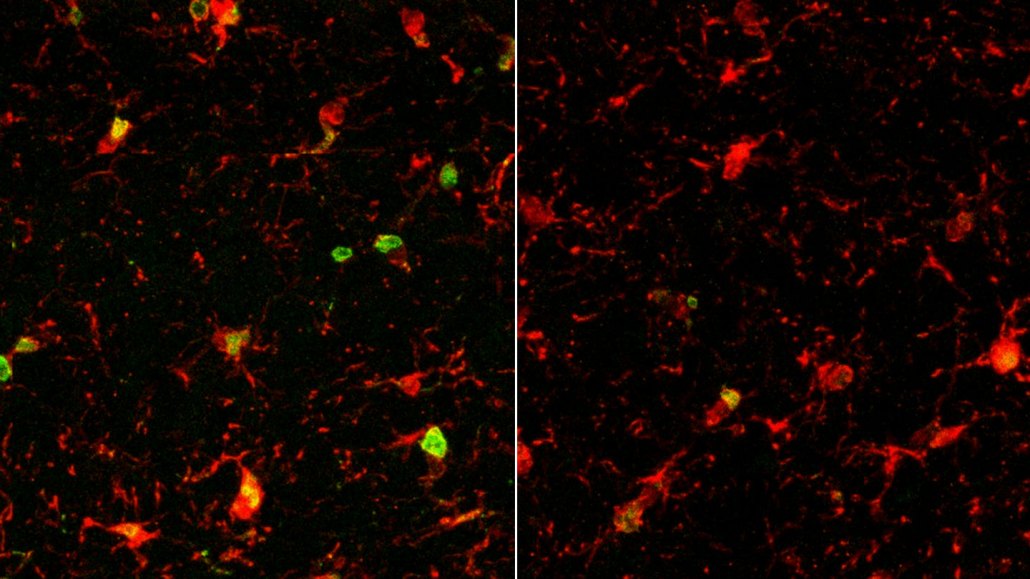Three ways of rejuvenating aging brains may work via the same protein
The molecule may be a promising therapy but exactly how it works is unclear

Inflammation in the brain can happen with age. In the brains of old mice, scientists found that age-related inflammation (stained green and yellow) in immune cells was prevalent in untreated mice (left) but was greatly reduced in mice treated with PF4 (right).
Adam B. Schroer
A single molecule may play a central role in rejuvenating aging brains, albeit in different ways, new research suggests.
Studies of three different techniques for combating the cognitive decline that accompanies aging found that they all increase levels of a protein called platelet factor four, or PF4, in mice. This in turn improved the animals’ cognitive performance and improved biological signs of brain health, three research groups report August 16 in Nature Aging, Nature and Nature Communications.
“PF4 may be an effective factor, and this kind of work will help bring it toward a therapeutic agent” for age-related cognitive decline, says bioengineer Michael Conboy, of the University of California, Berkeley, who was not involved in the work.
One of the research groups, led by neuroscientist Dena Dubal, of the University of California, San Francisco, was studying klotho, a hormone linked to longevity. The group’s previous studies showed that injecting the hormone into mice boosted cognition, but since klotho molecules are too large to cross the blood-brain-barrier, the researchers concluded that the hormone must act on the brain indirectly via a messenger.
To search for this intermediary, Dubal’s team injected mice with klotho and measured changes in protein levels in the animals’ blood. Levels of platelet factors increased, and PF4 changed the most, the researchers found.
Platelets are a type of immune cell known for their role in wound healing and clotting, and they release proteins called platelet factors into the blood. “My first reaction was, what do platelets have to do with cognitive enhancement? This is crazy,” Dubal says.
Another UCSF team, led by neuroscientist Saul Villeda, had previously shown that blood plasma from young mice rejuvenated the brains of elderly mice. When they looked at how young plasma differed from old, Villeda’s team found it contained much more PF4.
Chatting over coffee, the two scientists shared what they were working on. “We had both, through our independent studies, converged on PF4,” Dubal says.
Soon after, Tara Walker, a neuroscientist at the University of Queensland, Australia, contacted Villeda. Walker’s team had found that exercise boosts PF4, and that delivering PF4 directly to mice’s brains spurred new nerve cell growth, called neurogenesis, in the hippocampus, a brain region crucial for memory. “We said, ‘OK, we need to start having meetings,’” Villeda says.
The new studies all show that PF4, on its own, improves cognition in mice. Walker’s team found that injecting PF4 into mice’s bodies also enhances neurogenesis, and that this is required for the cognitive benefits they saw. Dubal’s team found that PF4 also enhances neural connections in the hippocampus.
Villeda and colleagues were interested in the immune system. “More and more research is pointing toward a link between the immune system, cognitive decline and diseases like Alzheimer’s,” Villeda says. Injecting PF4 into old mice returned their body’s immune systems to a more youthful state, lowering levels of inflammatory proteins and reducing inflammation in their brains, the team found.
PF4 is a promising new player, but it is one part of a complex puzzle. “These discoveries greatly advance our understanding by unraveling one factor,” says neuroscientist Lida Katsimpardi, of the Pasteur Institute in Paris, who was not involved in the work. “We always want to know the full puzzle, but understanding each factor fills in a piece.”
Katsimpardi studies GDF11, a protein with similar restorative effects, that she and her colleagues have linked to calorie restriction. How big a part any of these proteins play is not yet clear. “This is the question we all have every day,” Katsimpardi says. “Is this the molecule? Or do you need more?”
The main limitation of the new studies is that few findings in mice translate into safe and effective therapies in people. But in humans, as in mice, PF4 declines with age, and human PF4 also improves cognition in mice, the researchers found.
Dubal and colleagues also published a study in July in Nature Aging showing that klotho improves cognition in aging monkeys, whose brains are much more similar to ours, though whether that improvement involves PF4 is not known. “It might be klotho that makes it to humans, or it could be PF4, or both,” Dubal says. “But it’s important to have multiple shots on goal.”
Ways of fighting brain aging that scientists already know work, such as exercise and calorie restriction, are often not an option for those most in need. “We know exercise is great, but you can’t do it because you’re frail. Same with calorie restriction,” Villeda says. Research like this aims to discover how these activities rejuvenate the brain and to identify molecules that mimic their effects.
The researchers plan to start testing treatments based on PF4 in humans within the next few years, Villeda says, but it will be important to watch for side effects. Future studies will also need to pin down exactly how PF4 acts in the body and brain, and whether it should ultimately be part of a therapeutic cocktail, Conboy says.






